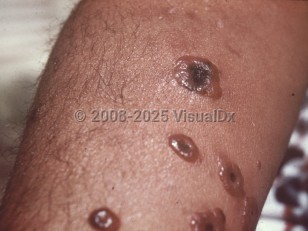Cutaneous anthrax
See also in: Cellulitis DDx,External and Internal EyeAlerts and Notices
Important News & Links
Synopsis

Bacillus anthracis is present in both domestic and wild animals throughout the world (mainly in agricultural regions of South and Central America, Southern and Eastern Europe, Asia, Africa, the Caribbean, and the Middle East) and can be transmitted by these animals' meat, wool, or hides. Therefore, veterinarians and those in the meat-, wool-, or hide-processing industries, as well as those who have butchered meat or touched raw meat, may develop cutaneous lesions.
Bacillus anthracis is not routinely found in all US soil, although it can be found in soil where previously infected animals have died. Major epizootics in the past have occurred in North Dakota, South Dakota, Minnesota, and Texas. Hence, international travel should be elicited when evaluating a suspect lesion.
Cutaneous anthrax lesions evolve from nonpainful, pruritic papules to clusters of vesicles to ulcers within 1-2 days following exposure of abraded skin or wounds to the spores. The ulcers then develop into depressed, black eschars over the next 2-5 days. The most common areas affected are the arms, face, and neck. Some lesions may have extensive edema formation. The incubation period is 1-12 days.
With antibiotic treatment, the mortality rate for cutaneous anthrax is approximately 1%. However, without treatment, it may progress to a systemic form of anthrax with a mortality rate of approximately 20%. In these cases, the spores introduced into the body are eaten by macrophages and taken to regional lymph nodes, where they germinate into bacteria. Released into the lymph system, they enter the blood stream, causing septicemia-releasing toxins that result in a fatal toxemia.
Codes
A22.0 – Cutaneous anthrax
SNOMEDCT:
84980006 – Cutaneous anthrax
Look For
Subscription Required
Diagnostic Pearls
Subscription Required
Differential Diagnosis & Pitfalls

Subscription Required
Best Tests
Subscription Required
Management Pearls
Subscription Required
Therapy
Subscription Required
Drug Reaction Data
Subscription Required
References
Subscription Required

